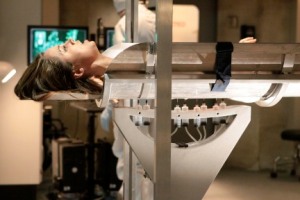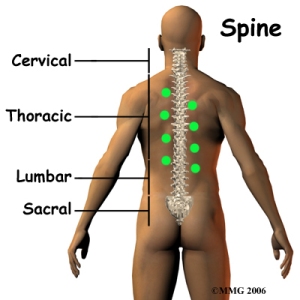How to Kill Your Imaginary Friends: Joss Whedon, I’m calling you out.
by Dr. Grasshopper
***This post includes Dollhouse spoilers. You have been warned.***
I was watching the Dollhouse episode entitled “Hollow Men” (2×12) the other day. And there was this scene. You probably know the one I’m talking about. It involved lots of needles. It involved cerebrospinal fluid. And it involved absolutely indefensible pseudo-medical ridiculousness. It looked a little like this:
Now, at first it didn’t really occur to me to say anything about it. I just cringed in the way that I usually cringe at complete medical BS, and mentally started preparing my usual speech to any of my patients who might have seen the episode about how “television is absolutely nothing like reality, so please bear with me while I try to figure out whether you have meningitis or not.”
And then I saw this blog post:
And I thought, great, Joss Whedon…lumbar punctures the way they happen in reality aren’t scary enough? Now we have to make people think we’re going to lower them screaming onto a bed of giant horse needles? Seriously? My job isn’t hard enough? There’s not enough anti-doctor sentiment running around?
Now I have to convince my overly-to-the-point-of-unnecessarily-anxious patients that, even though spinal taps are certainly no fun, they’re not actually about to be inserted into a hyper-futuristic-and-evil-looking torture device!
And then I remembered…
I have a blog now.
Yes, ladies and gentlemen, it’s time to buckle up. Because what we have here is another occasion in which a writer sacrifices any semblance of medical plausibility in order to grab at false drama. And I’m going to call him out.
(Ok, you knew I had to drop that in here somewhere.)
What is cerebrospinal fluid?
Cerebrospinal fluid (CSF) is a watery substance that surrounds the brain and the spinal cord. It is produced by the choroid plexus in the ventricles of the brain, circulates through the blue area you see below, and is absorbed into the venous circulation through structures called arachnoid villi in the skull.
The function of cerebrospinal fluid is to support the metabolism of the brain while providing a cushion against mechanical injury. It’s what separates your soft brain tissue from your hard skull so you don’t bruise it every time you shake your head in despair at the medical misinformation you’re seeing on the TV screen.
(And it’s apparently a repository for imprint-immunity. ::shrug::) PS: That part I could suspend my disbelief for. It wasn’t great medicine, but the hand-waving was perfectly adequate for what they were trying to do, in my opinion.
What is a spinal tap?
A spinal tap, also known as a lumbar puncture, is a bedside procedure in which a doctor uses a needle to draw cerebrospinal fluid out of the space that surrounds the spinal cord. (Whedon got at least that much right.)
So what’s your problem?
That was practically the only thing he got right. Ok, that and kind of the general color of the “cerebrospinal fluid” that ended up in the syringes. (Although it was too dark. Cerebrospinal fluid isn’t THAT yellow. Maybe she had xanthochromia? Okay, we can go ahead and say that the Active architecture is responsible for that. ::sigh::)
Here are my main problems with the sequence:
Boyd: “The entire process was designed to extract your spinal fluid without killing you.”
Really, Boyd? You went to the trouble to design a whole process to extract CSF without killing the subject? Really? Wow. How ingenious of you. Was Topher in on it?
You know, even as a supervised medical student (the lowest of the low, training-wise…ask any nurse in the universe), I still never killed a patient with a lumbar puncture. As a matter of fact, none of my classmates did either. Or my residents. And we did a good number of lumbar punctures during my training.
The normal spinal tap procedure is perfectly adequate for life-preservation purposes. You didn’t have to design a new, overcomplicated device for the sole purpose of doing a simple bedside procedure.
But thanks for your thoughtfulness.
Basic anatomy
Okay. We’re going to start with that needle array. Ignore the ridiculous size of the needles; we’ll attribute that to TV-screen needs. Scroll up and take a close look at that picture at the top of the post. Where the heck do the Evil Rossum Folks think the spine is?
As far as I can tell, here’s where the needle array would hit Echo’s back:
And…um…here’s where a spinal tap is actually supposed to take place:
Only there?
Yes, only there. That’s the place you do a lumbar puncture: in the space between the vertebrae of the lumbar spinal column. Take a second, and put your hands on your lower back. Feel the top of your hips? Good. Move your hands to the center of your back until you feel your spine. That’s about where a lumbar puncture is supposed to happen.
Too much higher and you risk hitting the spinal cord, which is the long, thin extension of nervous tissue that serves as the communication wire between the brain and the body.
Actually, it’s lucky that Boyd and his Evil Rossum “doctors” have no idea where the spine is. Those needles were seriously hitting her all the way up to the level of her shoulders! Paralysis, anyone?
Positioning
Although, to be honest, even if the needle array was in a straight line directly beneath Echo’s spinal column, she’d probably still be all right. The needles would never get past her vertebrae.
The vertebrae are the bones that protect your spinal column from injury. And what’s a spinal tap if not a carefully controlled, therapeutic injury?
In order to get to the place where the CSF lives, you have to direct a needle BETWEEN the vertebrae of the spinal column. It’s not as easy as it might seem. And you certainly can’t do it blindly, by positioning a needle under a person and then lowering the person onto the needle. That’s just absurd.
This is a picture of a needle being directed between the vertebrae of the lumbar spine. The person in the picture is facing to your left. The needle is coming in through the person’s back.
That needle position would probably get to the CSF. But you’d never be able to do that to Echo, not the way she was lying on the table. Flat. On the table.
I’ll show you a couple of pictures of lumbar punctures from various educational materials. See if you can catch a pattern that Echo does not follow.
Every time you see a person getting the procedure done in these pictures, they’re CURLED UP.
That’s because the vertebrae, in their general orientation, are really well-positioned to protect the spinal cord from any intrusion. You have to change their general orientation to get any kind of access at all to the spinal cord.
Usually you ask a patient to curl up on their side, or dangle their legs over the side of the bed and curl their chest to their knees. This opens up the vertebrae in the back, at least a bit. Enough to pass a needle through. Hopefully.
Since Echo is flat on her back, I’d bet that the bony processes that you see to the right of the needle-position picture would block any intrusion that the needle array could possibly threaten. You know, if the needles were even positioned between the vertebrae. You know, if the needles were even positioned under the spine.
Infection control
The Evil Rossum “doctors” are sticking needles (supposedly) into Echo’s spinal column. To extract CSF from a space that communicates with Echo’s brain.
Luckily, they’re using proper sterile technique, so she doesn’t get an infection in that very attractive-to-buggies culture medium.
Oh wait. No, they aren’t. They’re wearing bunny suits and nitrile gloves. Those aren’t sterile materials. But we can forgive that; they’re cheap costumes and it’s a flipping TV show. And anyway, even I agree that it’s important to have “hands of blue” at least somewhere in your Evil Corporation.
So we’ll let that one pass, because at least they’ve properly prepared the site (oh, sorry, sites) of the puncture(s), making sure the overlying skin has been cleaned so the needle doesn’t carry bacteria with it into the spinal column.
Oh, wait. No, they didn’t. As a matter of fact, it even looks like several of those needles are going right through Echo’s bra-thingy. Okay. Not sterile. At all.
Okay…at least they’re wearing masks and caps. I guess that’s going to have to be good enough.
No local anesthesia
We all know that Joss Whedon likes to torture his characters. (And emotionally torture his audience, when he can manage it.) So of course Boyd’s Evil Rossum “doctors” aren’t going to bother with local anesthetic when they’re performing a painful procedure.
But in real life, you numb the area before digging around with a needle. It’s just what you do.
Okay, okay, I get it. Joss Whedon did absolutely no research on lumbar punctures for the “Hollow Men” episode, and as a result, he’s made your job harder and you’re annoyed. This post is getting really long.
Yeah, it is. Thanks.
So. In summary.
Boo to Joss Whedon for potentially scaring the crap out of my patients for the sake of a big, dramatic torture scene that makes no medical sense whatsoever. It’s unnecessary. Patients already have enough scary stuff to deal with.
And on my end, it feeds right into the exceedingly popular “doctors-are-evil” stereotype that I have to fight every day in order to even start doing my job.
Lumbar punctures are not fun for the patient, and are also not fun for the physician. But they’re not as bad as Joss Whedon wants you to think they are. So please don’t freak out if you have to get one.
Sources:
Junqueira, Luis Carlos; Jose Carneiro. Basic Histology: Text and atlas. 11th ed. McGraw-Hill, 2005
Pictures:
http://www.walgreens.com/marketing/library/contents.jsp?doctype=10&docid=000303
http://images1.sfuniverse.com/files/2009/12/DH-Ep212_Sc32_4742.jpg
http://stolemyhubcaps.com/movietxt.htm
http://graphics8.nytimes.com/images/2007/08/01/health/adam/9587.jpg
http://cmejama-archives.ama-assn.org/sub-journals/jama/html/content/vol296/issue16/images/medium/jrc60004f4.jpg
http://www.gc100.com/assets/images/cerebrospinal_fluid.jpg
http://painguru.net/pain_clinic_images/rf_spine_anatomy01%5B1%5D.jpg
The contents of this site, such as text, graphics, images, and other material contained on the Site (“Content”) are for informational purposes only. The Content is not intended to be a substitute for professional medical advice, diagnosis, or treatment. Always seek the advice of your physician or other qualified health provider with any questions you may have regarding a medical condition. Never disregard professional medical advice or delay in seeking it because of something you have read on this Site!
If you think you may have a medical emergency, call your doctor or 911 immediately. This blog does not recommend or endorse any specific tests, physicians, products, procedures, opinions, or other information that may be mentioned on the Site. Reliance on any information provided by this blog, or other visitors to the Site is solely at your own risk.
The Site may contain health- or medical-related materials that are sexually explicit. If you find these materials offensive, you may not want to use our Site. The Site and the Content are provided on an “as is” basis.
If you use this as if it were real medical information, I will be incredibly upset. But I still won’t lower you onto a bed of horse needles. Because that’s just silly.
—
Reprinted with permission from Joss Whedon, I’m calling you out on How To Kill Your Imaginary Friends, by Dr. Grasshopper
with permission from Joss Whedon, I’m calling you out on How To Kill Your Imaginary Friends, by Dr. Grasshopper
Dr. Grasshopper is a science fiction and fantasy author who is finishing up medical school and seeking residency in the field of internal medicine.










